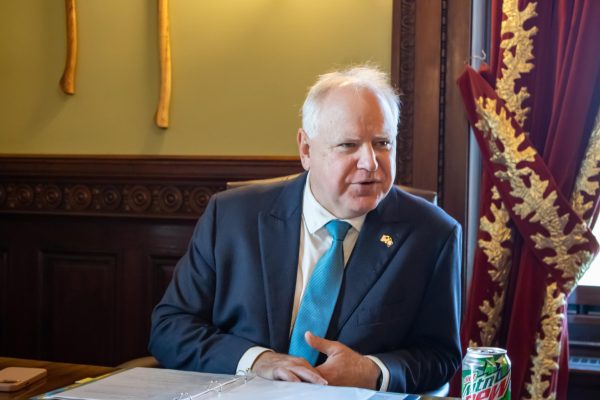Hundreds of protesters with the activist group March for Our Lives marched from 12th and Washington Avenues to Minneapolis City Hall on June 12. Activists called for gun control measures to be taken in the wake of high-profile mass shootings, such as at Robb Elementary School in Uvalde, Texas on May 24.
According to the Gun Violence Archive, a nonprofit that tracks nationwide gun violence incidents, 293 mass shootings have occurred in the U.S. so far this year, which is on track to match or surpass the country’s highest year on record.

On Friday, Congress passed a bipartisan bill on gun safety measures focused on preventing mass shootings, representing the first federal gun control legislation passed in nearly three decades. President Joe Biden signed the bill into law on Saturday.
The bill includes funding for school safety and mental health resources, background checks for people between the ages of 18-21 and encouraging states to pass “red flag” laws that would allow a judge to take away a person’s gun if they are deemed at risk to hurt themselves or others.
Young people made up the majority of activists at the protest, including high school students such as 17-year-old Maya Fritz, who spoke toward the start of the event. She said she was “fed up” after hearing about Robb Elementary.
Fritz told a story of a lockdown taking place at her high school, saying she texted her mom “I love you” while huddled in the band room, fearing for her life.
“It is not an if, if something will happen at our school, it is a when, unless we do something about it,” Fritz said during the speech.
Another speaker at the event was 24-year-old Diana Hernandez, who graduated from the University of Minnesota this year and is a member of the Minnesota Immigrant Rights Action Committee. She said she was advocating for the passing of federal gun control legislation instead of at the state or city level.
“As long as there is no substantial action at the federal level, guns are going to be able to go in and out of the state,” Hernandez said.
After arriving at City Hall, protesters laid down in front of the building as if they were students participating in an active shooter drill.
“I just hope someone who has power and legislation can take notice and make change, even if it’s slow, just to start moving in the right direction,” protestor and Minneapolis resident Bryce Pyle said.
Messages from University Activists and Leaders
Activists and leaders within the University have been advocating for change at the local, state and federal levels.
Carter Yost, president of the College Democrats of Minnesota, described his experience advocating for gun control as a “brutal sense of exhaustion.” Yost has been advocating for increased gun regulations since his early teenage years.
Yost organized the first March for Our Lives in his hometown of Lincoln, Nebraska, in 2018. When asked to reflect on the status of the movement today, he said, “[I feel inspired] that people continue to advocate, and deeply sad that they’ve had to.”
Beyond the realm of gun regulation, Yost said there is a need to reform the way mental health is currently treated. Yost said he has had “a lot” of conversations with students who feel mental health resources fall short of their needs.
“Gun violence will not stop if some states take action and others don’t,” Yost said. “The crux of the issue is a need to focus on tangible policy change in Congress.”
In an email to The Minnesota Daily, the University said the loss of life to mass shootings is “extraordinarily heartbreaking.”
“Emergency preparedness is critically important to campus operations systemwide and we have protocols in place to respond to shootings or other large-scale public safety threats,” the University wrote.
Medical professionals stress investments in gun violence prevention
Experts in public health are reflecting on gun violence’s effects on children’s health.
“We have laws that help protect public health,” Former President of the Minnesota Medical Association Marilyn Peitso said. “And in the matter of gun safety, we are sorely lacking in laws.”
Peitso graduated from the University’s Medical School and has been practicing pediatric medicine for over four decades. Throughout her practice, she said she has seen many changes in the way the state approaches gun safety.
“When I trained as a student, and a resident, and an early practitioner, we had none. We did not have shooter drills,” Peitso said.
In May, guns were declared the leading cause of death in children. Peitso said physicians now counsel parents on explaining gun violence to children. She said there is a need for increased funding for school counselors, decreased costs for mental health professionals and new regulations for trauma informed care.
“Minnesota has really stuck out as a state that has a low ratio of counselors to students,” Peitso said. “That really has long been a concern of pediatricians, the mental health care establishment and education. So having mental health services available in schools really is key.”














